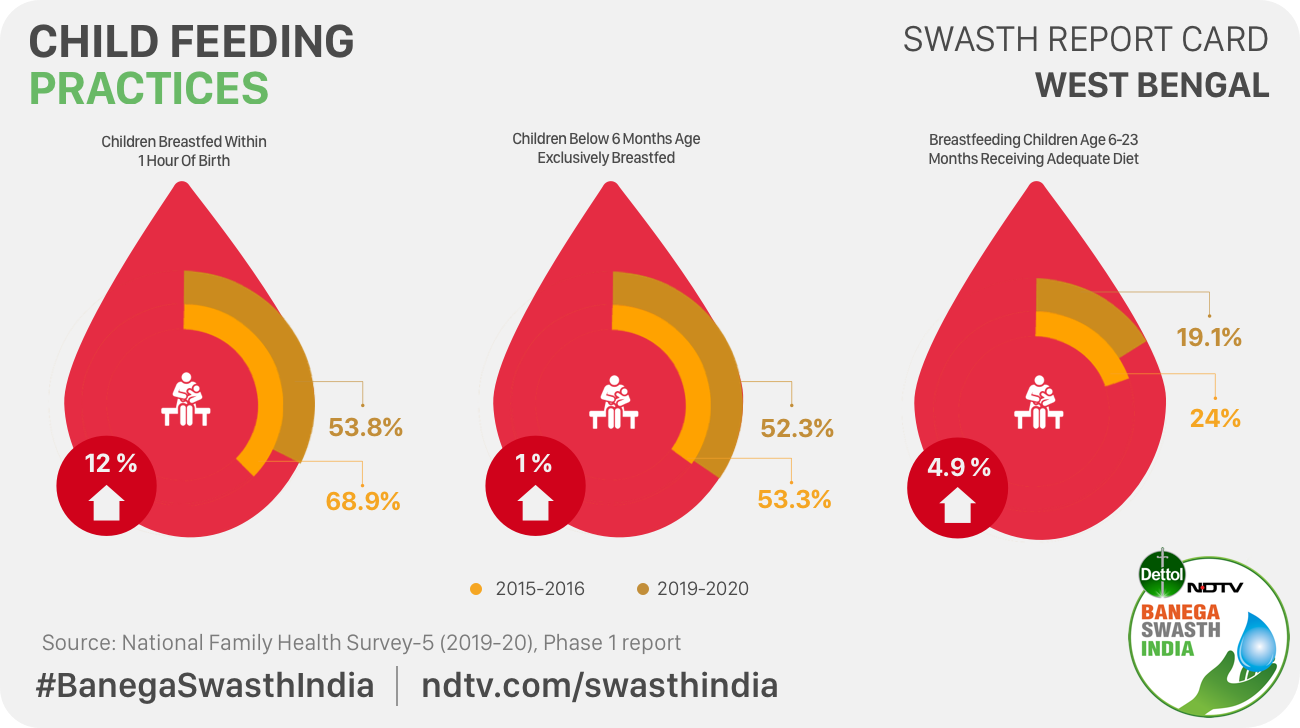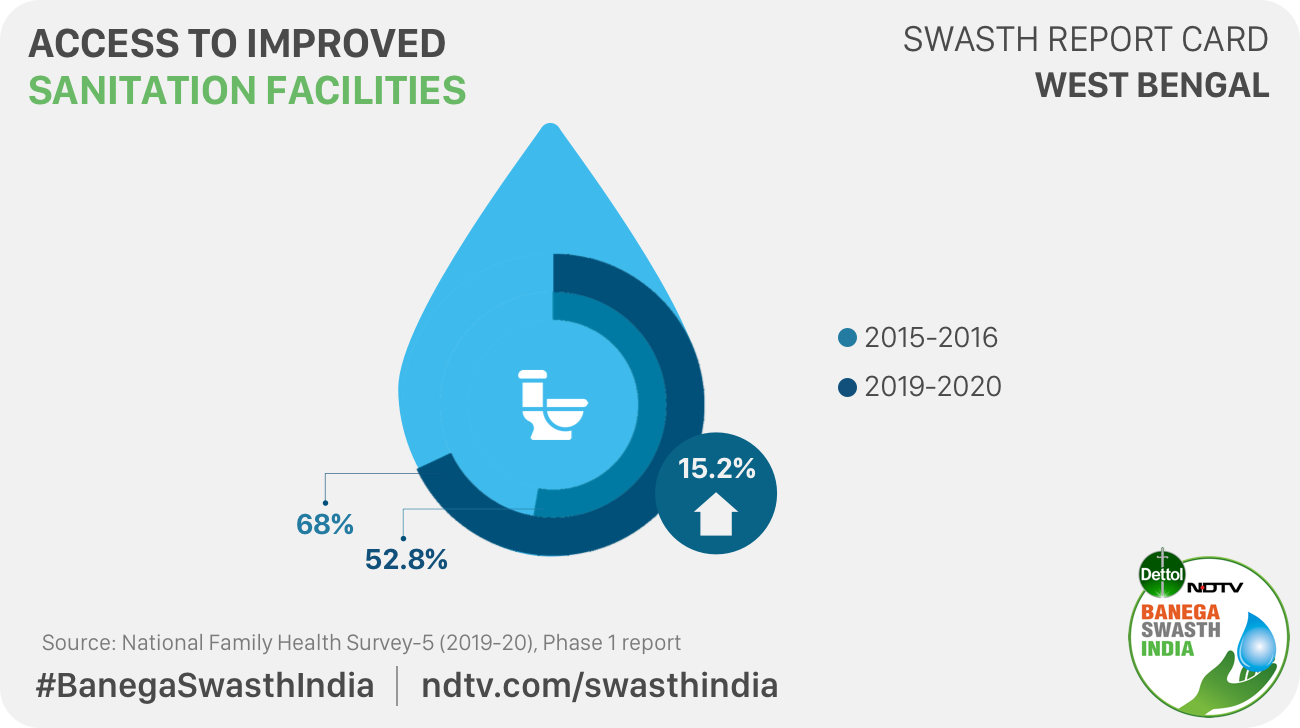Highlights
- - Over 18,000 households were surveyed in West Bengal under NFHS-5
- Malnutrition has increased in the state over the last five years
- The infant and child mortality rates in West Bengal have improved: NFHS-5
New Delhi: In 2017, Chief Minister Mamata Banerjee announced that under-nutrition and anaemia amongst children and women will be reduced in the state in a targetted manner by the year 2020. For this, the government of West Bengal launched a state-level nutrition mission. However, the recently released findings of the phase-1 of the National Family Health Survey 2019-20 (NFHS-5) covering 17 states and five Union Territories (UTs) have highlighted a reverse trend in the gains made towards tackling malnutrition among children in the state. But, the survey also talks about the improvement in infant and child mortality rates and immunisation, an indication of improvements made in public health services and mother and child care in the state. NFHS-5 data collection for West Bengal was conducted from June 21 , 2019 to November 8, 2019, covering 18,187 households, 21,408 women, and 3,021 men. In NFHS-4, information was gathered from a sample of over 15,327 households, which covered 17,668 women, and 2,402 men.
Also Read: Comorbidities Proved Fatal In Most COVID-19 Deaths In West Bengal: Study
Here are some of the major health indicators that show the achievements of the state and the challenges facing it:
Decline In Infant And Child Mortality Rate Resulting From Improved Healthcare
The NFHS-5 data shows a declining trend in Infant Mortality Rate (IMR), which is the number of babies less than one year of age dying per 1,000 live births, and Under Five Mortality Rate (U5MR), which refers to the number of children dying before reaching the age of five years per 1,000 live births. According to Dr. Pritam Roy, Data Analyst and Public Health Expert from West Bengal, the improvement in the infant and child mortality rates reflect a progress in the state’s healthcare facilities for mothers and children.
The infant mortality rate (IMR) in West Bengal in NFHS-5 (2019-20) is estimated at 22 deaths per 1,000 live births before the age of one year. This is a decline of almost 21.4 per cent from the NFHS-4 (2015-16) estimate of 28 deaths per 1,000 live births. IMR reported by NFHS-4 was also a decline of almost 42 per cent from the NFHS-3 (2005-06) estimate of 48 deaths per 1,000 live births.
Similar positive trends have been recorded in Under-Five Mortality Rate. NFHS-5 shows that the U5MR in the state is 25.4 deaths per 1,000 live births which declined by almost 21 per cent from the U5MR of 32 in NFHS-4. This again was a significant improvement of almost 50 per cent from the U5MR of 60 per 1000 live births in NFHS-3.
Dr. Roy attributed the decline in mortality rates to various programmes implemented by the state and central governments like India Newborn Action Plan, Integrated Global Action Plan for the Prevention and Control of Pneumonia and Diarrhoea (GAPPD), Home Based Newborn Care and Home Based Young Care (HBYC), Programme Mother’s Absolute Affection (MAA), and Navjat Sishu Suraksha Karyakram (NSSK) Facility Based Newborn Care. In a bid to increase the healthcare for new mothers and babies, the state government is also setting up of Mother and Child Hubs in various districts. The aim of these hubs is to ensure quantitative and qualitative improvement in maternal and child health.
NFHS-5 data also shows that institutional deliveries increased significantly in the state from 75.2 per cent in 2015-16 to 91.7 per cent in 2019-20. According to Dr. Roy, this is also one of the factors contributing to the drop in the mortality rate among infants.
Also Read: IIT-Kharagpur Develops Low-Cost, Portable COVID-19 Testing Device
Increased Immunisation
According to the survey, there has been an improvement in full vaccination coverage among children aged 12-23 months, among those surveyed in West Bengal. It has increased from 84.4 per cent in NFHS-4 to 87.8 per cent in NFHS-5.
According to the Ministry of Health and Family Welfare, full immunisation implies vaccinating children with BCG (Bacille Calmette-Guerin) which is a vaccine for tuberculosis (TB), vaccines to prevent measles – MMR (measles, mumps, and rubella) and three doses each of polio (excluding polio vaccine given at birth) and DPT (diphtheria, pertussis, and tetanus).
Infant And Child Feeding Practices Improved Over The Past Five Years
According to NFHS-5, infant and child feeding practices have shown an improvement when compared to the data recorded under the NFHS-4. Among the children surveyed, about 59.4 per cent of the children were breastfed within one hour of the birth in 2019-20 which was only 47.4 per cent in 2015-16. There has been an increase of about 1 per cent in the proportion of children ( age 0-6 months) being exclusively breastfed in 2019-20 (53.3 per cent) as compared to 2015-16 (52.3 per cent).
Similarly, there has been a gain in the proportion of breastfeeding children in the age group 6-23 months receiving an adequate diet from 19.6 per cent in NFHS-4 to 23.4 per cent in NFHS-5.
Malnutrition: Gains Made In NFHS-4 Reversed In NHFS-5
According to the report, the proportion of the children under five years of age, among those surveyed, who are malnourished increased in West Bengal in 2019-20 as compared to 2015-16. NFHS-4 had reported an improvement in the proportion of children who were stunted or had low-height-for-age as it declined by 12.1 per cent from 45 in NFHS-3 (2005-06) to 32.5 per cent. However, stunting has now increased to 33.8 per cent, as recorded by NFHS-5. Stunting, as per Dr. Shweta Khandelwal, Head, Nutrition Research and Additional Professor, Public Health Foundation of India, reflects chronic undernutrition and is likely to have long-lasting adverse effects on the cognitive and physical development of a child.
Child wasting reflects acute undernutrition and refers to children who have low weight for their height. This parameter has remained stagnant in the state at 20.3 per cent. However, the proportion of severely wasted children has increased from 6.5 per cent in NFHS-4 to 7.1 per cent in NFHS-5.
When it comes to the proportion of underweight children, West Bengal has again seen an increase. While about 31.6 per cent of the children surveyed were underweight in 2015-16 which was an improvement from the NFHS-3 figure of 38.7 per cents, the proportion increased to 32.2 per cent in 2019-20.
Obesity among children has also doubled from 2.1 per cent in NFHS-4 to 4.2 per cent in NFHS-5.
High Prevalence Of Anaemia Among Women And Children
Like almost all other states, anaemia among children and women remain a matter of concern in West Bengal. Anaemia is a condition that is marked by low levels of haemoglobin in the blood which leads to reduced oxygen flow to the body’s organs. The percentage of anaemic children aged between six and 59 months, increased from 54.2 in NFHS-4 to 69 in NFHS-5.
The survey also reports that the percentage of pregnant women with anaemia increased from 53.6 in NFHS-4 to 62.3 in NFHS-5. Women aged between 15 and 49 with anaemia increased from 62.5 in NFHS-4 to 71.4 in NFHS-5.
The condition of Anaemia has worsened among men as well. As per NFHS-5 data, around 39 per cent of men interviewed in the survey were anaemic which is 8.7 per cent more than 30.3 per cent recoded by NFHS-4.
While talking about the status of malnutrition and rising anaemia in the state, Dr. Ajay Chakraborty, Director Health Services, West Bengal said,
On one hand, health service indicators such as mortality rates, vaccination show improvement, NFHS-5 indicates worsening of malnutrition among children. While we have to accept this as a fact that malnutrition is a big problem in the state as in the rest of the country, the data does not provide any causes of the rise in under-nutrition. We need more micro-level data to understand this. Another contradictory point that we are yet to decipher is that the survey data shows an increase in the iron-folic acid intake by the pregnant women from 6 per cent in NFHS-4 to 30 per cent in NFHS-5, but the recent findings also show an increase in anaemia among pregnant women. We are still waiting for further explanation on the findings and simultaneously, we are working on strategies to address any gaps in the implementation of healthcare programmes.
Dr. Roy said that on ground, the health schemes being implemented by the state government have increased coverage over the last few years; however, there is a need to modify strategies to achieve better health outcomes. He highlighted that NFHS-5 has presented pre-COVID data and the scenario may have worsened due to the pandemic and the lockdown induced by it.
More Women In West Bengal Are Adopting Hygienic Method During Menstruation
NFHS-5 has revealed an uptick in menstrual hygiene among women between 15 to 24 years of age in 2019-20, compared to NFHS-4. West Bengal saw a jump of 28.1 per cent in this area as 83 per cent of the women surveyed in the said age group were using hygienic methods of menstrual management as compared to 54.9 per cent in NFHS-4.
According to the Ministry of Health and Family Welfare, locally prepared napkins, sanitary napkins, tampons, and menstrual cups are considered to be hygienic methods of managing menstruation.
Access To Improved Drinking Water And Sanitation Facilities
According to NFHS-5, about 97.5 per cent of the sample population has access to improved drinking water sources in West Bengal which is almost same as in NFHS-4 (97.2 per cent). According to the Union Health Ministry, the sources of drinking water include piped water in the residence or piped to neighbour, public taps, tube-wells, dug-wells, rainwater tanks, community RO plants among others.
Only 68 per cent of the population surveyed has access to an improved sanitation facility, reveals NFHS-5. This is an increase of almost 15 per cent when compared to the population having access to toilets in NFHS-4 which was 52.8 per cent.
Improved sanitation facilities include flush to piped sewer system; flush to septic tank; flush to pit latrine; ventilated improved pit/biogas latrine; pit latrine with slab; twin pit / composting toilet that is not shared with any other household.
NFHS-5 noted a high urban-rural divide in access to improved sanitation facilities. 75 per cent of urban residents have access to improved sanitation facilities against only 64.7 per cent of rural population.
It is to be noted that the NFHS factsheet does not talk about the prevalence of open defecation in the state. However, the data on access to improved sanitation facilities challenges the state government’s claim of rural Bengal becoming open defecation free in August 2019. According to an official from Department Of Panchayats and Rural Development, over 135 crore rural households were covered under the state’s sanitation mission called ‘Mission Nirmal Bangla’. Some municipal bodies in the urban areas are yet to become ODF, said the official and as many as 52 municipal bodies were waiting to become ODF by November, 2019- when NFHS-5 data collection for West Bengal was concluded.
NDTV – Dettol Banega Swasth India campaign is an extension of the five-year-old Banega Swachh India initiative helmed by Campaign Ambassador Amitabh Bachchan. It aims to spread awareness about critical health issues facing the country. In wake of the current COVID-19 pandemic, the need for WASH (Water, Sanitation and Hygiene) is reaffirmed as handwashing is one of the ways to prevent Coronavirus infection and other diseases. The campaign highlights the importance of nutrition and healthcare for women and children to prevent maternal and child mortality, fight malnutrition, stunting, wasting, anaemia and disease prevention through vaccines. Importance of programmes like Public Distribution System (PDS), Mid-day Meal Scheme, POSHAN Abhiyan and the role of Aganwadis and ASHA workers are also covered. Only a Swachh or clean India where toilets are used and open defecation free (ODF) status achieved as part of the Swachh Bharat Abhiyan launched by Prime Minister Narendra Modi in 2014, can eradicate diseases like diahorrea and become a Swasth or healthy India. The campaign will continue to cover issues like air pollution, waste management, plastic ban, manual scavenging and sanitation workers and menstrual hygiene.
[corona_data_new]






























